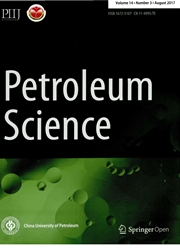

 中文摘要:
中文摘要:
为为记载的有线线路 NMR 和当钻时,记载的 NMR 并且为解释模型使用的工具的设计的特殊要求为原油由于 NMR 松驰的分散性质被要求。NMR 纵的松驰时间(T 1 ) 和有不同粘性的死了的油样品的横向的松驰时间(T 2 ) 被 NMR 分光计分别地在五不同温度与 2 MHz 和 23 MHz 的 Larmor 频率测量。结果显示出 1 显然是的 thatT 依赖于 NMR 的 Larmor 频率分光计。度经常, 1 分散与增加变得更强壮原油粘性, Larmor 频率和 2 是的粘性 / 温度 ratio.T 独立于 NMR 分光计测量频率。回声频率应该被选择,这被建议当时,比 2 降低 MHz measuringT 1 当 Larmor 频率比 2 MHz 高时,在记载当钻时和 thatT, 1 分散应该被改正。
 英文摘要:
英文摘要:
Special requirements for design of tools used for wireline NMR logging and NMR logging while drilling and for interpretation model are demanded due to the dispersion properties of NMR relaxation for crude oil. NMR longitudinal relaxation time (T1) and transverse relaxation time (T2) of the dead oil samples with different viscosities were measured by NMR spectrometers with a Larmor frequency of 2 MHz and 23 MHz at five different temperatures respectively. The results showed that T~ was obviously dependent on the Larmor frequency of NMR spectrometer. The degree of T1 dispersion became stronger with the increasing crude oil viscosity, Larmor frequency and the viscosity/temperature ratio. T2 was independent of NMR spectrometer measuring frequency. It is suggested that the resonance frequency should be selected lower than 2 MHz when measuring T1 in logging while-drilling and that T1 dispersion should be corrected when Larmor frequency is higher than 2 MHz.
 同期刊论文项目
同期刊论文项目
 同项目期刊论文
同项目期刊论文
 期刊信息
期刊信息
